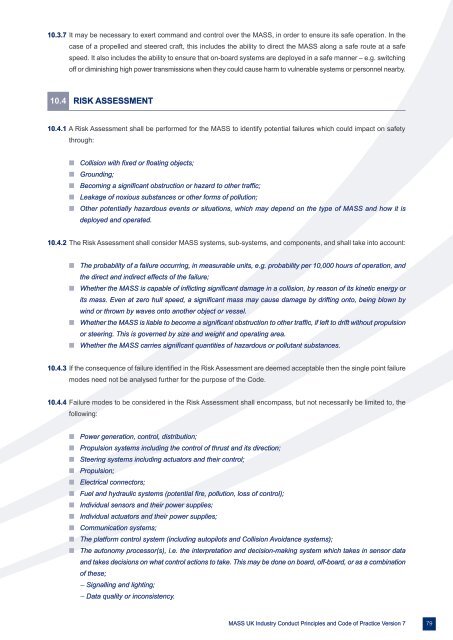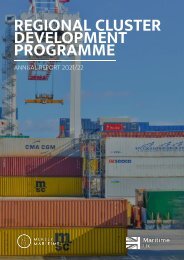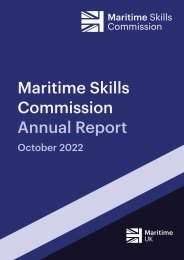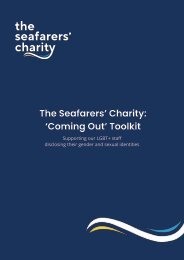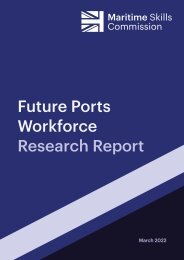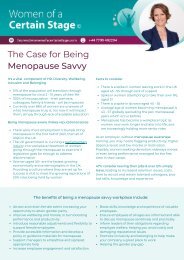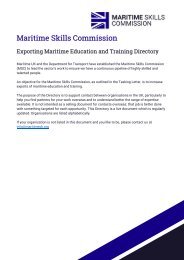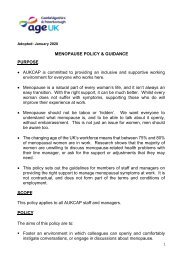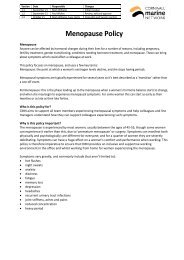COP_2023_V7_pages
You also want an ePaper? Increase the reach of your titles
YUMPU automatically turns print PDFs into web optimized ePapers that Google loves.
10.3.7 It may be necessary to exert command and control over the MASS, in order to ensure its safe operation. In the<br />
case of a propelled and steered craft, this includes the ability to direct the MASS along a safe route at a safe<br />
speed. It also includes the ability to ensure that on-board systems are deployed in a safe manner – e.g. switching<br />
off or diminishing high power transmissions when they could cause harm to vulnerable systems or personnel nearby.<br />
10.4 RISK ASSESSMENT<br />
10.4.1 A Risk Assessment shall be performed for the MASS to identify potential failures which could impact on safety<br />
through:<br />
n Collision with fixed or floating objects;<br />
n Grounding;<br />
n Becoming a significant obstruction or hazard to other traffic;<br />
n Leakage of noxious substances or other forms of pollution;<br />
n Other potentially hazardous events or situations, which may depend on the type of MASS and how it is<br />
deployed and operated.<br />
10.4.2 The Risk Assessment shall consider MASS systems, sub-systems, and components, and shall take into account:<br />
n The probability of a failure occurring, in measurable units, e.g. probability per 10,000 hours of operation, and<br />
the direct and indirect effects of the failure;<br />
n Whether the MASS is capable of inflicting significant damage in a collision, by reason of its kinetic energy or<br />
its mass. Even at zero hull speed, a significant mass may cause damage by drifting onto, being blown by<br />
wind or thrown by waves onto another object or vessel.<br />
n Whether the MASS is liable to become a significant obstruction to other traffic, if left to drift without propulsion<br />
or steering. This is governed by size and weight and operating area.<br />
n Whether the MASS carries significant quantities of hazardous or pollutant substances.<br />
10.4.3 If the consequence of failure identified in the Risk Assessment are deemed acceptable then the single point failure<br />
modes need not be analysed further for the purpose of the Code.<br />
10.4.4 Failure modes to be considered in the Risk Assessment shall encompass, but not necessarily be limited to, the<br />
following:<br />
n Power generation, control, distribution;<br />
n Propulsion systems including the control of thrust and its direction;<br />
n Steering systems including actuators and their control;<br />
n Propulsion;<br />
n Electrical connectors;<br />
n Fuel and hydraulic systems (potential fire, pollution, loss of control);<br />
n Individual sensors and their power supplies;<br />
n Individual actuators and their power supplies;<br />
n Communication systems;<br />
n The platform control system (including autopilots and Collision Avoidance systems);<br />
n The autonomy processor(s), i.e. the interpretation and decision-making system which takes in sensor data<br />
and takes decisions on what control actions to take. This may be done on board, off-board, or as a combination<br />
of these;<br />
– Signalling and lighting;<br />
– Data quality or inconsistency.<br />
MASS UK Industry Conduct Principles and Code of Practice Version 7 79


